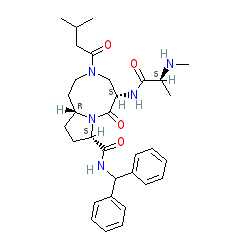GtoPdb is requesting financial support from commercial users. Please see our sustainability page for more information.
|
Synonyms: AT 406 | AT406 | Debio-1143 | Debio1143 | QCR-136 | SM 406
Compound class:
Synthetic organic
Comment: Xevinapant (formerly AT-406, Debio 1143) is an orally available inhibitor of IAPs (inhibitor of apoptosis proteins), that is in development for anticancer potential. It was initially developed by Ascenta Therapeutics, and was originally progressed by Debiopharm. Merck in-licensed the asset when it was in late stage development. Structurally, xevinapant is a small molecule SMAC mimetic; SMAC being an endogenous IAP antagonist. Inhibition of IAPs which are often overexpressed in cancer cells (blocking apoptosis) leads to cancer cell death. SMAC mimetic-induced cancer cell death appears to involve multiple pathways, including re-activation of the apoptotic pathway, and/or ubiquitin-directed degradation of IAPs, which promotes TNFα/caspase-8-induced cell death [2-3].
Ligand Activity Visualisation ChartsThese are box plot that provide a unique visualisation, summarising all the activity data for a ligand taken from ChEMBL and GtoPdb across multiple targets and species. Click on a plot to see the median, interquartile range, low and high data points. A value of zero indicates that no data are available. A separate chart is created for each target, and where possible the algorithm tries to merge ChEMBL and GtoPdb targets by matching them on name and UniProt accession, for each available species. However, please note that inconsistency in naming of targets may lead to data for the same target being reported across multiple charts. ✖ |
|
|||||||||||||||||||||||||||||||||||
| References |
|
1. Cai Q, Sun H, Peng Y, Lu J, Nikolovska-Coleska Z, McEachern D, Liu L, Qiu S, Yang CY, Miller R et al.. (2011)
A potent and orally active antagonist (SM-406/AT-406) of multiple inhibitor of apoptosis proteins (IAPs) in clinical development for cancer treatment. J Med Chem, 54 (8): 2714-26. [PMID:21443232] |
|
2. Petersen SL, Wang L, Yalcin-Chin A, Li L, Peyton M, Minna J, Harran P, Wang X. (2007)
Autocrine TNFalpha signaling renders human cancer cells susceptible to Smac-mimetic-induced apoptosis. Cancer Cell, 12 (5): 445-56. [PMID:17996648] |
|
3. Wu H, Tschopp J, Lin SC. (2007)
Smac mimetics and TNFalpha: a dangerous liaison?. Cell, 131 (4): 655-8. [PMID:18022360] |







